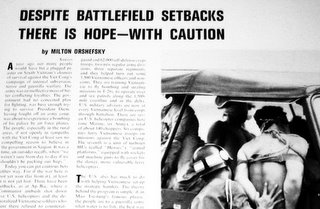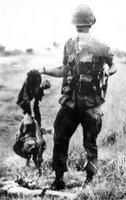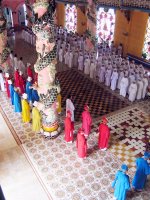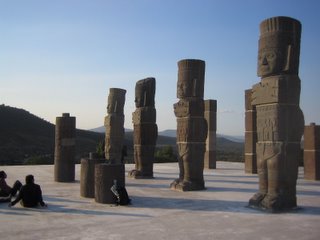Mention Saigon and it doesn't take long for thoughts of the Vietnam War to come to mind. And so it was yesterday, our last full day in Saigon (or, officially, Ho Chi Minh City), when we visited the War Remnants Museum, an incredibly moving reminder of the horrors of war generally, and of the atrocities perpetrated during the Second Indochinese War (i.e. the Vietnam War) in particular -- the unbelievable cruelty, the widespread environmental devastation, and the immense loss of life on all sides, as well as the continuing suffering of the many thousands severely deformed as a result of exposure to Agent Orange.
It was on one level a civil war, Viet against Viet, but really it is the tremendous American intervention that one remembers, and for good reason, as the war would almost certainly not otherwise have been so bloody and so protracted. What is not often recalled is the role of American allies (amongst others, the Australians, New Zealanders, South Koreans and Filipinos) who contributed forces stationed in the south -- one cannot help but see the parallels with the present-day campaigns of the United States and its current coalition allies.

Guarded optimism in contemporary magazine coverage of the war -- again, not at all dissimilar to much of the coverage on Afghanistan and Iraq more recently.

There is a photo of a GI holding a disembodied piece of a VC girl soldier up and apparently laughing, and the caption by the reporter wonders if this was a man or a monster. Perhaps the sad truth is that war makes monsters of all its boys and girls -- how else would you be able to kill and maim every day, and keep yourself together?
Also worthy of a mention before we leave Vietnam (in a few hours) is our visit to the Holy See of the Cao Dai religion. The very grand "cathedral" at Tay Ninh is a confused confection of styles, in keeping with its syncretism of Taoist, Buddhist, Confucian and Abrahamic beliefs -- the universe is ruled by the Jade Emperor, who has made several revelations to Man (including to Moses, Lao Tzu and Buddha) and the aim of adherents is to cut through the cycle of rebirth and proceed directly to Nirvana. I suppose as a set of beliefs it is no more or less ridiculous than any other, but I will admit to finding it less than compelling. I think I am reacting especially badly to the adoption of a formal structure modeled on the Church of Rome!

The building itself is a classic basilica in plan and in basic structure, but the end result is much wilder than anything in Rome -- dragons swirl up tall oriental columns topped by Corinthian capitals, holding aloft a sky-blue vaults embellished with clouds and even more dragons. Below, a bewildering array of geometric tile designs jostle for dominance, creating a violent visual vibration that is rather at odds with the airy, quiet serenity you might experience were you to keep your eyes closed. Entirely dominant at the far end of the nave is the all-seeing Divine Eye, mounted on a huge blue-green sphere, behind gilded altars and piles of fresh fruit, whilst keeping watch overhead are what appear to be reliefs of Buddha, Lao Tzu, Confucius... and possibly Victor Hugo (revered as a pre-eminent saint amongst Cao Daists)!
Menciona Saigon y después de un poco normalmente piensa sobre la guerra de Vietnam. Visitamos el "War Remnants Museum" (el Museo de los Vestigios de la Guerra) en Saigon (o, oficialmente, Ho Chi Minh City), un recuerdo muy commovedoro de los horrores de guerra en general, y los atrocidades de la Segunda Guerra de Indochina en particular -- la crueldad increíble, la devastación del medio ambiente, y la gran pérdida de vidas de todos, además del dolor que continua hoy de las muchas miles con deformedades severas a causa de Agent Orange.
En cierto modo fue una guerra civil, Viet contra Viet, pero es la gran intervención de EEUU que se recuerda, y por buena razón, porque si no la guerra no habría ser tan sangrienta o extensa. Lo que no es se recuerda a menudo es la papel de los aliados de EEUU (entre otros, los Australianos, los Neozelandeses, los Koreanos y los Filipinos) que enviaron soldados -- es claro el paralelo con las campañas actuales de EEUU y sus aliados corrientes.
Además, vale la pena mencionar nuestra visita a la capital de la religión de Cao Dai. La gran "catedral" en Tay Ninh es una confección confusa de estilos, como su syncretismo de creéncias taoistas, budistas, confucianas y abrahamicas -- el universe se gobierna por el emperador jade que ha dado unas revelaciones a la humanidad (incluso a Moses, Lao Tzu y Buddha) y el objetivo de sus partidarios es acortar el ciclo de renacimiento y ir directamente a Nirvana. Supongo que no es más o menos ridículo que otras colecciones de creéncias, pero confieso encontrarla poco convincente. Pienso que estoy reaccionando mal a la adopción de una structura formal que se basa en la iglesia Romana!
 Penang, the island of my birth. I very rarely feel sentimental about any place that I might call 'home' but I will admit to the odd twinge of fondness whenever I return to Penang. What brings it on? It could be the charming old streets of Georgetown, or the (relatively) laid-back pace of life, or the indescribably amazing food, or the dramatic sunsets that draw each day to a close. Or perhaps my memories of raising hell with my cousins around my grandad's old shop in Perak Road and his old house in Mount Erskine (both long since obliterated to make way for new development) with his amazing collection of stuffed beetles and snakes, of trundling down Macalister Road in a rickshaw, of building sand castles at Batu Ferringhi, of mammoth Chinese New Year banquets and kaleidoscopic lantern festivals, of incomprehensibly shrill performances of Beijing opera at makeshift streetside theatres. Much of the Penang I remember is already gone, thanks to rapid and poorly managed development -- beautiful old buildings have disappeared, the popular beaches are much dirtier, the views to the hills now interrupted by mushrooming tower blocks -- but much of it is still as it was and it remains a truly special place.
Penang, the island of my birth. I very rarely feel sentimental about any place that I might call 'home' but I will admit to the odd twinge of fondness whenever I return to Penang. What brings it on? It could be the charming old streets of Georgetown, or the (relatively) laid-back pace of life, or the indescribably amazing food, or the dramatic sunsets that draw each day to a close. Or perhaps my memories of raising hell with my cousins around my grandad's old shop in Perak Road and his old house in Mount Erskine (both long since obliterated to make way for new development) with his amazing collection of stuffed beetles and snakes, of trundling down Macalister Road in a rickshaw, of building sand castles at Batu Ferringhi, of mammoth Chinese New Year banquets and kaleidoscopic lantern festivals, of incomprehensibly shrill performances of Beijing opera at makeshift streetside theatres. Much of the Penang I remember is already gone, thanks to rapid and poorly managed development -- beautiful old buildings have disappeared, the popular beaches are much dirtier, the views to the hills now interrupted by mushrooming tower blocks -- but much of it is still as it was and it remains a truly special place. Someone else's photo of a beach in Penang. I hear that the only good beaches are the ones that are in out-of-the-way places, unsurprisingly, with names (like 'Muka Head') that I don't know because no one ever went there when I was little.
Someone else's photo of a beach in Penang. I hear that the only good beaches are the ones that are in out-of-the-way places, unsurprisingly, with names (like 'Muka Head') that I don't know because no one ever went there when I was little.




























